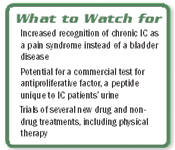Article
Pain management plays more prominent role in interstitial cystitis
Today, interstitial cystitis is being viewed more as a painsyndrome than as a bladder disease, and that new view is drivingmuch of the research that urologists will hear about at this year'sAUA annual meeting and beyond. It should also inform their approachto treatment until the cause and cure are discovered, according toPhilip M. Hanno, MD.

That new view is, in fact, what has prompted evolution of the name of this disorder to "painful bladder syndrome" or PBS/IC, noted Dr. Hanno, professor of urology at the University of Pennsylvania Health System, Philadelphia.
The concept doesn't seem to square with the breakthrough discovery of antiproliferative factor (APF), the peptide unique to IC patients' urine that has also been discovered to damage the bladder lining. But Dr. Hanno said he believes that PBS/IC likely starts out as either a pelvic floor dysfunction or as a bladder disease. In the case of bladder disease, because effective bladder treatments are lacking, the problem can become a chronic pain syndrome over time.
"I think pain management should have a bigger role in PBS/IC, and my personal preference is that any patient who has reached the point where narcotic therapy is indicated should be seen in conjunction with a pain management specialist who is an expert in narcotic therapy," Dr. Hanno told Urology Times.

"What's come through in the literature in the last couple years is that the potassium test is not a good diagnostic test and has fallen off of the diagnostic algorithm. Maybe if we really attack what the cause is-if it is APF and we attack that-then we could head this disease off at the pass," he said.
APF research may also yield revolutionary treatments farther in the future.
Treatments in the pipeline
In Atlanta, urologists will hear about new potential treatments for IC pain. For example, ajulemic acid, or IP 751, is a cannabinoid that produces analgesia without a "high" and is in clinical trials for neuropathic pain. Now it's being tried in animal models of IC with a liposome delivery vehicle and apparently reduces the pain response to bladder irritation. Even the liposomes themselves seem to calm bladder hyperactivity and may be more effective than DMSO (Rimso-50) instillation or pentosan polysulfate (Elmiron).
Also in their earliest phases of testing are a vitamin D analog, a novel sodium channel blocker, and a novel ATP-sensitive potassium channel opener that target signaling pathways involved in bladder hyperactivity. Another treatment that reduces pain and other IC symptoms as well is hyperbaric oxygen, which has been tested in a small, controlled clinical trial.
More IC treatments that urologists will likely hear about at future meetings are entering clinical trials. Small studies showing positive effects with low doses of the immunosuppressives mycophenolate mofetil (CellCept) and cyclosporine in severe IC as well as of short-term steroid therapy in patients with Hunner's ulcers have renewed interest in immune system dysfunction in IC. There have also been anecdotal reports of improvement in IC symptoms in patients who also had connective tissue disease and were treated with immunosuppressive disease-modifying antirheumatic drugs.
Newsletter
Stay current with the latest urology news and practice-changing insights — sign up now for the essential updates every urologist needs.





